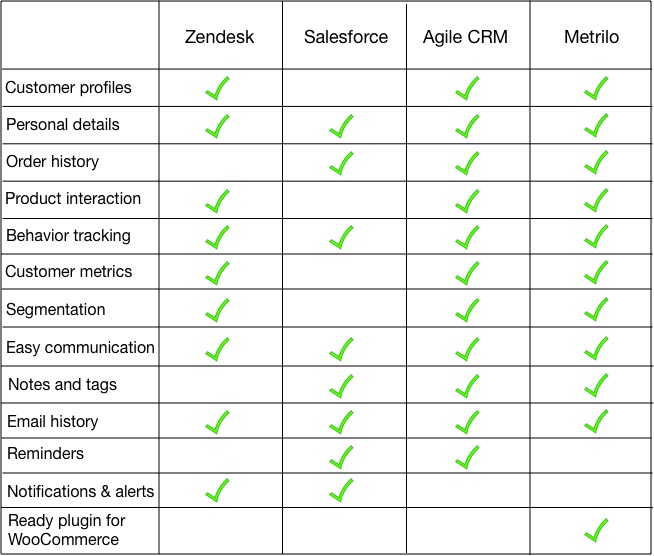
How to choose a WooCommerce CRM and improve customer engagement
Top WooCommerce CRMs compared
A CRM sounds so corporate! But big companies’ only chance to be close to their customers is organizing all the data they have about them and using it wisely. You can’t form any relationship if your info is scattered and unusable.
Why do you need an WooCommerce CRM at all?
We talked to the owners and managers of WooCommerce stores of different sizes about what made them look for such a tool and what they expect from a CRM.
They all revolved around the following:
A CRM helps you understand your customers deeper, respond to their needs better, communicate more effectively and sell more as a result.
To be honest, right now WooCommerce doesn’t give you anything on your customers. You can’t even see order history.
Compiling customer profiles, on the other hand, and observing behavior builds a fuller picture of the individual customer. You learn from their indirect feedback (actions).
Their personality, preferences, tastes, and shopping habits are displayed better and better with every session. You see how they decide to buy something and what grabs their attention.
When you know so much about them, you can customize their experience completely – show special product pages, tailor messages in response to different concerns, offer only products they’ve shown interest in, use promotions proven to work with that group…
Customers appreciate when you don’t just blast them with marketing, but watch and listen. And they respond more positively to hyper-targeted marketing because it’s serving them what they want or need on a silver platter.
Personalization helps you sell the same products to different customers – to each in their own way.
What to look for when choosing a CRM for your store?
WooCommerce CRM features to look for:
- Comprehensive customer profiles
- Individual sessions
- Identification of customers, not aggregated data
- Behavior tracking
- Customer metrics
- Filters and customer segmentation
- Ability to contact customers from the platform
- Communication history
- Notes, comments and tags
The common trait of entrepreneurs is the lack of time. Any WooCommerce customer relationship manager should save time and give insights in a ready-to-use form.
Related: What tasks should ecom entrepreneurs delegate
Here’s what kind of features will give you those insights.
Comprehensive customer profiles
In the WooCommerce admin panel all you see is a name, contact and separate order values. While the platform is sales-oriented, the CRM to complete it is people-oriented so you match revenue with real people.
The most important thing a CRM does is organizing customer data:
- contact details,
- buying behavior,
- product and category interaction,
- are they a new or a returning customer,
- source of acquisition,
- order history and current order statuses, etc.
You should be able to look through that customer profile and form a feeling for this person – what they are interested in, what kind of a shopper they are, and how to best reach out to them.
After all, to be able to sell to them, you have to meet the people behind your orders.
Actions (behavior) on site
The next major requirement is that the CRM tracks customer behavior on site in real time – how they interact with your site, how often they buy, what seems to bother them and how best to engage them.
That’s a gold mine of information on buying behavior. If you hope to do effective marketing, it has to be tied to what people do – otherwise, you’re just blasting selfishly. To influence the buying process, you have to observe it first.
With a behavior-tracking tool, you’ll get to see the process behind people’s buying decisions, how long it takes and what’s important (e.g. return policy) to them.
Then, you can target their concerns in your communication, help them decide faster, and time the next messages for when they’ll be ready to shop again.
Bonus: Notifications & alerts
Some merchants like having notifications (alerts) for customer activities. You can have a live feed to monitor everything that’s happening instead. For really important events like hitting the high-spender threshold, set up tags to be automatically assigned.
Customer metrics
It’s true some platforms (e.g. Magento) display individual Lifetime Value, Average Order Value, the number of orders and so on. If your platform doesn’t, it’s good to have it in the CRM you choose.
The numbers each customer makes you are the culmination of all their actions and interaction with your store. To have a well-working machine, you have to keep an eye on the end results, right?
These metrics are a great base for segmentation (see below) and can help you understand why some people end up spending more than others.
Filters and customer segmentation
Talking about filters – they are the way to make sense of all the individual info you have available. Filtering gives you narrower sub-groups of your customers to target more effectively.
All in all, segmentation works wonders because it’s based on customer actions – you’re not pushing anything unwanted, only what they’ve responded well to in the past.
Plus, it’s very convenient to be able to save segments like “high spender”, “frequent buyers”, “deal hunters”, “new collection lovers” and so on, and use them over time.
Ability to contact customers from the platform
Having all information is next to useless if you can act on it. The CRM you choose for your store should let you reach out to your customers from the system directly – via email, phone or chat.
Naturally, it’s not ideal to filter and everything and then to export a list to a separate email tool. It’s even worse if you spot a problem with one customer and can’t message them right away.
When customer management and communication happen on the same platform, you can monitor and adjust your efforts accordingly – like remove a tag that no longer applies to a customer. Putting the data from different platforms together is always a pain.
Notes, comments, and tags
That one’s obvious. There’s always something to add that doesn’t fit in any of the pre-set fields. A good WooCommerce CRM will offer you a free field for notes and comments.
This way, the whole team is on the same page with client communication and specifics.
Another useful idea for tags – define groups by the way they like to be marketed to (Facebook, email, content…) and engage accordingly. There’s no point in sending emails to everybody when half of your list comes from FB every time and never opens emails, right?
Communication history
Naturally, sales teams like keeping track of the communication they’re having with prospects and customers.
If you use chat or phone, the CRM you pick better integrate with the system. Even if it doesn’t, you should be at least able to track what emails they’ve received and how they reacted (opened, clicked, unsubscribed).
This will help you and your team be on the same page with the customer and not forget they sent a return. Also, it’s feedback on your marketing messaging – what makes them take the action you want and what doesn’t work.
Bonus: Reminders
Some of the merchants we talked to needed to set reminders to do a certain thing with a certain client – a phone call, refund an order, etc.
Whether you’re a one-man-show or have a team, reminders can be handy to keep you organized.
Now, these are the requirements we found to be mentioned most often by the shop owners we talked to. Each business has unique work flow and you can probably add to that list.
However, a study by GetApp about what SMBs look for in a CRM found that:
- 92% are focused on basic needs like automation and lead tracking
- 37% of SMBs needs a CRM that keeps their leads more organized
- 42% need to be able to reach their contacts via email through the CRM
We wanted to check if the available tools live up to expectation and compared them to help you choose.
Here’s the checklist we’re using:
Customer profiles
Personal details
Order history
Product interactions
Activities/ behavior on site
Metrics
Filters/ segmentation
Ability to contact customers from the platform
Notes, comments and tags
Communication history
Reminders
Notifications & alerts
What CRMs for WooCommerce are out there?
There are actually 6 separate products that together form the Zendesk customer service system. For best results and maximum data, you need all products to work together. Also, it integrates with things like Salesforce for revenue analysis so it’s a bit more corporate than the average online store.
It’s focused on communication (it’s a service tool, not a management one), but merchants use the data it accumulates too.
The downside might be the price. Every feature is billed separately and you can mix and match functionality, but it’s complicated and not easy to estimate upfront.
This one is on the enterprise end of CRM solutions – focused on B2B sales and deal tracking.
It actually is made up of 3 main products – sales, customer service and marketing software, priced separately, and various add-ons.
It boasts clients like Facebook, Toms, Coke and Harvard.
It has CRM, Marketing and Support functionalities, both for offline and online businesses. Only, the reports are a bit more SaaS- oriented. It can integrate with other tools like Zendesk to pull more info.
Pricing is affordable – $80 a month on the most advanced plan.
The Metrilo CRM is built for WooCommerce especially. It gathers, processes and lets you use all customer info to market personally and effectively. The WooCommerce integration is seamless and lets you start using customer data in just a few minutes after connecting your store.
It’s one product that has CRM, email (+ automation) and analytics features that all work together. Pricing is based on the features you use and starts at $119.
We put together a comparison table for those CRMs.

So choose wisely and not based on price only – it needs to have the functionality you use the most.
Even though it seems most CRMs have the basic features, they differ in actual abilities. For example, they collect different personal details. Our bet is on the ones created specifically with online stores in mind like Metrilo.
Try Metrilo for free
WooCommerce CRM, analytics & email in one
Build and grow your ecommerce brand
Metrilo’s mission is to help you build your ecommerce brand and win your place in the customer’s heart. We share what we learn from our daily work with product innovators and founders here. Subscribe to our weekly newsletter to get the freshest lessons and conquer your niche.
We promise, no spam.
Thank you for subscribing!
See you soon :-)



